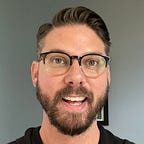Design Leadership Stories: Welcome Aboard
I have been rapidly building a team. Humble brag; I assembled a team of 3 Product Designers and a User Researcher in 60 days. How I did that is for another post, but what I have now is a brand new team of eager and excited professionals who need to learn as quickly as possible.
Everyone learns differently. I should know this better than anyone, I am dyslexic. I didn’t learn the same way as my classmates in school, and I still experience this today. It is important to realize that everyone has found a way that works for them, but the one thing I have learned that is common amongst all highly skilled and motivated individuals is that they want to add value as soon as possible. Especially creatives, who want to get into the solving of problems as fast as possible because it’s what they love to do. Left too long to absorb information or “learn the ropes” and they can get discouraged or even depressed. So, how do I approach onboarding a new team quickly, but not rushing that very unique and important time of starting a new position at a new company? With structure and guidance.
Below are the sections that I built into a Product Designer’s or User Researcher’s onboarding doc.
//Company Background
The company mission, vision, origin story, and how it makes money.
//The Design Org And Immediate Team
Vision for the org, mission, expectations of product designers who join, how we meet as a team and the types of meetings a designer could expect to be in, our process diagram, and the team members themselves.
//About The Customers
For us, this is a link to persona documentation. Other examples are user journey maps (if they exist), or a Jobs Map. But anything about your users, internal and external, is key for putting your designers in the right mindset.
//First Two Weeks
I have been told this is the most useful part of our onboarding. This list of tasks to complete really sets the new employees up for success. By having an easy to reference place to refer to when they have completed all their paperwork and most impactful 1:1s, they can begin to dig into more complex documentation or begin on tasks that will build their confidence and autonomy. Here are some examples from ours:
- Schedule 1:1s with your peers, directors, and C suite
- Read your team’s user manuals and then create your own user manual
- Change your LinkedIn, celebrate your new milestone!
- Start to read the following books…
- Start your diary and check in with your manager about your observations
- Get familiar with your internal tools
- Watch these videos and interviews with our customers
//User Manuals and Diaries
Above in that list I mention a User Manual and a Diary. These are great docs for you, as a leader, to have. Here is my User Manual as an example of how someone could create a reference for team members on how to work with me. Some of my designers got really creative with theirs and built them in Figma! The diary is great for both the manager and the new employee. By having someone new keep a diary, it allows them to purposefully reflect on how things are going and allows them to capture all the fresh thoughts so that after a while of being on the job, they can go back and reference things they learned or thought the company could change to make it better. I like to go back and review the diary with my folks after 90 days.
Last thing I like to do once a new designer has joined and had some time with the onboarding doc is to remind them of the cognitive bias curve. If you are aware of it and how it can affect the way you think about learning new, complex information, it can help bypass some of the negative effects it can have.
User experience can start with a team’s experience. Employee experiences can set the tone for how they tackle human problems in your products. The better experience they have and the more context they can readily get, the better the customer experience will ultimately be.
How do you onboard your new folks? What has worked really well for your teams?
